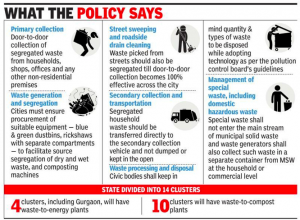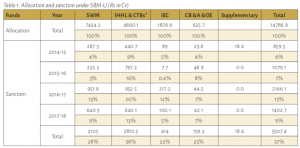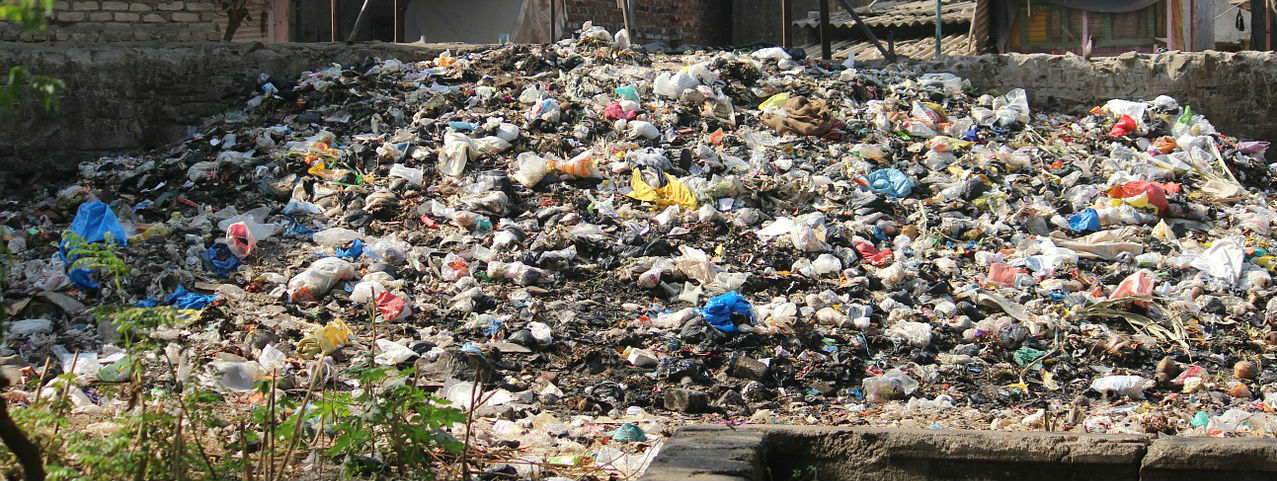No amount of symbolic sweeping of roads by people is enough to address the environment and health crisis of unmanaged waste in India. The garbage so collected is simply dumped at a different place. A recent Supreme Court (SC) judgment (In Re: Outrage as Parents End Life after Child’s Dengue, 2017) noted that the crisis of unmanaged garbage dumps was a severe challenge that most states have ignored.
Swachh Bharat Mission (SBM) aims to provide sustainable solid waste management (SWM) to 80% of the urban population in India. In pursuance of this objective, the Municipal Soild Waste Management (MSWM) 2016 rules were promulgated at the Centre, and around 50% of the SBM budget allocated for this. Yet, the problem subsists, and in fact worsens, as the rate of urbanisation increases, with more than ten states processing less than 10% of the waste they collect (Khan, 2018). MSWM is a key element towards sustainable metropolitan development, comprising segregation, storage, collection, relocation, carry-age, processing, and disposal of solid waste in order to minimise its adverse impact on the environment (Joshi & Sirajuddin, 2016).
Recently, Haryana as well as several other states notified their state policy on the strategy on SWM to comply with the SC directive In Re: Outrage as Parents end life after Child’s Dengue (Government of Haryana, 2018). This article attempts to:
- Identify the present challenge of MSWM in Haryana;
- Understand the 2018 Haryana state policy on MSWM; and
- Analyse the effectiveness of this policy to tackle the problem of MSWM in Haryana.
Municipal Solid Waste in Haryana
Presently, 81 local bodies in Haryana produce 4,500 tons of waste per day (Government of Haryana, 2018). Haryana processes less than 6% of the total waste generated. Most of the garbage collected is dumped on empty fields and grounds. Some of the common concerns with dumping garbage in the open are:
- Groundwater contamination by the leachate generated by the waste dump;
- Surface water contamination by the run-off from the waste dump;
- Bad odour, pests, rodents and wind-blown litter in and around the waste dump;
- Generation of inflammable gas (e.g. methane) within the waste dump;
- Bird menace above the waste dump that interferes with aircraft routes;
- Fires within the waste dump;
- Erosion and stability problems relating to slopes of the waste dump;
- Epidemics spread through direct or indirect contact with stray animals;
- Acidity caused in the surrounding soil; and
- The release of greenhouse gas (Ministry of Housing and Urban Affairs, 2018).
As the quantity of garbage produced bludgeons, the lack of proper planning in its collection and disposal exacerbates an already looming health and environmental crisis.
The solid waste production in Haryana is estimated to increase to 7,500 tons/day by 2035, according to government statistics (Government of Haryana, 2018). In light of this, the existing infrastructure in Haryana is equipped to tackle approximately 450 tons/day (ibid.). This means that the present infrastructure can handle only 5% of estimated waste generated in the coming decade. This creates an urgent need to provide a sustainable multi-agency framework to handle municipal solid waste.
Recognising the need for a regulatory framework to handle the problem scientifically, the Ministry of Environment, Forests, and Climate Change (MoEFCC) issued the MSWM Rules, 2000. Recently, a new set of rules were introduced in the MSWM Rules, 2016. In the present article, the rules are discussed in context to Haryana with reference to the collection and handling of waste.
Haryana State Policy and Strategy on Solid Waste Management, 2018
The Haryana government recently issued the State Policy and Strategy on SWM to comply with the MSWM Rules 2016 (Government of Haryana, 2018). A snapshot of this is seen below:
The salient features of the policy are –

Source – Pant, Shubhra (2018) : Government Defines Cleaning Rules, Times of India
The important administrative principles of the policy have been summarised in the table below:
| MSWM Policy of Haryana, 2018 – A Snapshot | ||
| Body In-Charge of Implementation | Department of Urban Local Bodies, Government of Haryana | |
| Hierarchy of Preference/Focus for MSWM
(from most to least preferred) |
Source reduction and reuse
Recycling Composting Waste to Energy Landfill |
|
| Aims | Achieve 80-100% door to door collection (Chapter 10, p. 14-15)
Separate collection, transport and disposal of dry, wet and hazardous waste (Chapter 11, pp. 15-16) Making Urban Local Bodies (ULBs) “Bin Free”, i.e., no storage of garbage within the city premise (Chapter 13, p.17) |
|
| Financing Mechanism (Chapter 16, p 19) | Ministry Budget
Local Taxes (recommends an identifiable portion of property tax termed as “conservancy charges” to be utilised for this purpose) User Charges Subsidies under SBM EPR (Extended Producer Responsibility) |
|
Implementation Challenges of Haryana’s MSWM Policy
The next section describes the implementation challenges identified with Haryana’s MSWM Policy.
1.Lack of Political and Administrative Will
The MSWM 2016 requires all states and Union Territories to provide a detailed plan under Rule 6 (b) within six months of the notification of the Rules (Almitra H. Patel v. Union of India , 2015). Yet, there were two separate litigations that had to be undertaken before the state as well as the Central Pollution Control Board (CPCB) complied with various provisions of the Rules. The CPCB issued a suggestive action plan to manage solid waste in 2016 only after the National Green Tribunal (NGT) directed the CPCB to take stock of the implementation in Almitra H. Patel v. Union of India (Almitra H. Patel v. Union of India , 2015).
Similarly, at the level of the state, the SC of India had to intervene. In Re: Outrage as Parents end life after Child’s Dengue, the SC had to direct non-complying states to create the statutorily required state level Advisory Board under Rule 23 of the Act (In Re: Outrage as Parents End Life after Child’s Dengue, 2017). Haryana notified the composition and creation of this body only in 2018 (Urban Local Bodies Department , 2018). Similarly, the present policy has also been notified only in 2018 – two years after the Central Rules for this were drafted.
2.Inadequate Clarity about Timelines
There is limited clarity timelines that the ULBs have to comply with under the State Policy. This is in clear violation of the Central MSWM Rules 2016, which provide a proper timeframe within which to implementation the Rules, under Rule 22 of the Policy (Government of India, 2016).
According to the Rules, within two years of the notification of the Rules, segregated waste has to be collected door to door (Government of India, 2016). Clearly, such deadlines have been missed by the Haryana government. These rules are mandatory and clearly to be implemented without any exception. In absence of a timeline, the incentives or motivations of ULBs stay exactly the same, as they were under the old system.
3.No Mechanisms to Deal with Existing Solid Waste
As the government continues to miss various deadlines for installing a suitable waste management programme for the state, the amount of existing untreated waste is increasing. Yet, there is no mention in the policy for handling this waste.
4.Funding and Performance of ULBs
Although the SBM has a budgetary allocation for SWM, the allocation of funds from this segment has been abysmal. In 2014-15, only 4% of the allocated fund was sanctioned for use. The sanctioned budget expenditure has never been higher than 13% of the total annual budget allocated to SWM. (Khan, 2018)

Source – Khan, Sama (2018): Swachh Bharat Mission (Urban) Need v. Planning, Centre for Policy Research
There are two plausible explanations for such severe under-utilisation:
- The magnitude of the problem does not justify the large volume of expenditure; or
- There is severe administrative lethargy in applying for the grants and implementing the programme.
Given the preceding discussion on the scale of the problem, there is little doubt about the severity and urgency of the problem. In the absence of adequate checks and balances, the policy, albeit well designed, is merely an ink-on-paper approach to solving the real challenge of sustainable SWM.
Conclusion
Undoubtedly in the case of SWM, as with healthcare, prevention is better than cure, in that reducing the amount of solid waste generated is an effort worth pursuing. However, the focus of this article was to analyse existing efforts to disposal of solid waste, once produced. In particular, it reviewed the MSWM Policy of Haryana, 2018, and showed how it is largely a policy implementation challenge. Given the plethora of social and economic challenges Haryana and India face today, arguably, SWM does not figure as a top priority among policymakers, perhaps explaining the evident lethargy and lack of will in implementing policy. However, given the rapid rate of population growth and its increasing demands on urbanisation, political will in this sphere needs to be created through appropriate carrot and stick mechanisms. Indeed, addressing solid waste disposal is not a wasteful idea!
Bibliography
- Jadhav, R., 2018. 75% of municipal garbage in India dumped without processing. Times of India , 30 July .
- Ministry of Housing and Urban Affairs, 2018. Principles of Solid Waste Management. [Online]
Available at: Click Here
[Accessed 10 Septmeber 2018]. - Government of Haryana, 2018. Haryana State Policy and Strategy on Solid Waste Management, Panchkula: Directorate of Urban Local Bodies.
- Joshi, R. & Sirajuddin , A., 2016. Status and challenges of municipal solid waste management in India: A review. Cogent Environmental Science, 2(11).
- Government of Haryana, 2018. Haryana- State Policy and Strategy on Solid Waste Management , Panchkula: Directorate of Urban Local Bodies .
- Almitra H. Patel v. Union of India (2015).
- In Re: Outrage as Parents end life after Child’s Dengue (2017).
- Urban Local Bodies Department , 2018. Notification No. 14/12/2018. [Online]
Available at: Click Here
[Accessed 11 09 2018]. - Government of India, 2016. Solid Waste Management Rules 2016, New Delhi: s.n.
- Khan, S., 2018. Swachh Bharat Mission (Urban) Need v. Planning, New Delhi: Center for Policy Research.

